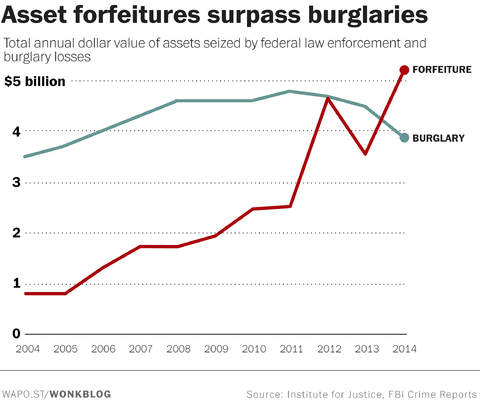Civil asset forfeiture
(theft) | |
|---|---|
 | |
| Interest of | • DEA • Immigration and Customs Enforcement |
| A "controversial" US government policy in which property is forcibly transferred to government agencies from its legal owners because they suspect it may have been derived from criminal activity. | |
Civil asset forfeiture, or Civil seizure is the forced removal of property by authorities without having to prove that it was gained illegally. While people are assumed innocent unless proved guilty, this is not sufficient in some countries (notably the USA) to prevent their property being forfeit. If they wish to try to get back the seized property, owners must prove, at their own expense, that it was not accrued through criminal activity. In 2014, the total value of property taken by USA government agencies exceeded the amount stolen from USA citizens by burglars.
Official narrative
As of 2017, even Wikipedia admits that the practice is "controversial".[1]
Prevalence
The practice is widespread in USA, but was abolished in New Mexico in 2015. Different standards of proof are required in different states. NYPD has draconian civil asset forfeiture laws.[2]
Rise and rise
In USA, according to official statistics, some $93.7 million of property were seized in 1986. By 2004, this had risen to $567 million,[3] and $1.6 billion by 2008. In 2010, it was $2.5 billion. The Washington Post reported in November 2015 that "in 2014, for the first time ever, law enforcement officers took more property from American citizens than burglars did."[4]
References
- ↑ https://en.wikipedia.org/w/index.php?title=Civil_forfeiture_in_the_United_States&oldid=765229752
- ↑ http://theantimedia.org/nypd-steals-18000-knife-law/
- ↑ http://www.forbes.com/2011/06/08/property-civil-forfeiture.html
- ↑ https://www.washingtonpost.com/news/wonk/wp/2015/11/23/cops-took-more-stuff-from-people-than-burglars-did-last-year/
